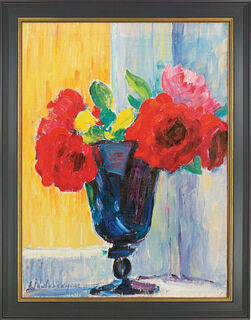Picture "Rose in Blue Vase", framed


Picture "Rose in Blue Vase", framed
Quick info
limited, 950 copies | original Dietz replica | oil on cardboard | framed | size approx. 58 x 45 cm (h/w)
Detailed description
Picture "Rose in Blue Vase", framed
Original: Private collection.
Original Dietz replica. Oil on cardboard in 78 colours. Limited edition of 950 copies. Framed with dark real wood strip. Size incl. frame approx. 58 x 45 cm (h/w).

About Alexej von Jawlensky
1864-1941, German-Russian painter
It was not until 1889 that the former Russian Imperial Guard Alexej von Jawlensky in the Tsarist army began his artistic training. In 1896, he moved to Munich to attend a private art school where he met Wassily Kandinsky. In Murnau Jawlensky first worked together with Kandinsky and Gabriele Münter. And together they founded the Artist's Association "Neue Künstlervereinigung München". In addition, Jawlensky was a key member of the "Blauer Reiter" movement. He later co-founded the group "The Blue Four" with Klee, Kandinsky and Feininger.
Expelled from Germany as a Russian citizen in 1914, during the beginning of World War l, the artist settled in Switzerland and later in Wiesbaden, Germany. During this time he created his famous abstract heads. Jawlensky died of a serious illness in 1941.
"My art is meditation or prayer in colours", Jawlensky once said, and indeed his work is characterised by great religiousness. This is particularly noticeable in the series of works of the Saviour’s faces and the abstract heads, which Jawlensky summarises in his memoirs as "saints' heads". The influence of orthodox iconography is unmistakable, and they were already understood as a modern version of the icon by contemporary artist colleagues. The human face in many variations – mostly in strong, even bright colours – had already been a focus of his work before. With the saints' heads, he became more restrained in colour and reduced the subject of the portrait to the face itself. They seem de-individualised without losing expressiveness. A progressive abstraction, lead to an iconic form, which in the sequence seem like a search for an unattainable divine archetype.
Influenced by Fauvism, Alexej von Jawlensky painted with bright colours, fierce brushwork and dark outlines. His works are among the most sought-after works of classical modernism and can be found in the world's great museums.
Günter Dietz developed a revolutionary method for the authentic reproduction of paintings, where not the usual printing inks are used, but the same original colours used by the artist. Depending on the artist's painting technique, up to 140 (!), different paint applications need to be applied in order to achieve a perfect replica of the original that also tangibly reproduces the "relief" and pastosity of colour composition.
Here are the examples of 'Couple at the Garden Table' by August Macke:

Furthermore, the same material as the original, such as reproduction on canvas, paper, wood, copper, parchment is always used.
The result is a perfect, gridless reproduction that comes very close to the original in expressiveness and effect. Even museum specialists often can not distinguish the replica from the original. Therefore, a special security note must be added, which is visible only under X-rays.
The edition of most Dietz replicas is limited, usually to 950 copies. Each canvas replica is stretched onto a frame as the original, so you can retighten the canvas in case of fluctuations in room temperature and humidity. A high-quality solid wood strips round off every Dietz replica.
Numerous masterpiece paintings of Rembrandt, Caspar David Friedrich, Claude Monet, Gustav Klimt and various others have been recreated by the "Dietz Offizin". Famous modern artists such as Pablo Picasso, Salvador Dalí, Max Ernst, Friedensreich Hundertwasser, Joan Miró and Marc Chagall have used this method developed by Günter Dietz in order to have replicas of their works produced.
Press comments:
"The Dietz System provides images as good as the originals. What the electronics did with the invention of Hi-Fi and stereo for music playback - here the graphic technology made up for visual art." (Die Zeit, German newspaper)
"In theory, there is no difference between the original and the Dietz replica. They should not be called reproductions, but facsimiles." (Newsweek, US-American news magazine)
"For art printers all over the world remains unrealizable to this day, what Dietz only managed with the help of printing technology: The perfect reproduction of painted works." (Der Spiegel, German news magazine)
Artistic movement that replaced Impressionism in the early 20th century.
Expressionism is the German form of the art revolution in painting, graphic art and sculpture, which found its precursor in the works of Paul Cézanne, Vincent van Gogh and Paul Gauguin in the late 19th century. The Expressionists attempted to advance to the primal elements of painting. With vibrant, unbroken colours in large areas and with the emphasis on the line and the resulting targeted suggestive expressiveness, they fought against the artistic taste established by the bourgeoisie.
The most important representatives of Expressionism were the founders of "Die Brücke" (The Bridge): Ernst Ludwig Kirchner, Erich Heckel, Karl Schmidt-Rottluff, Max Pechstein, Otto Mueller and Franz Marc, August Macke and others.
Masters of Viennese Expressionism are Egon Schiele and Oskar Kokoschka. Among the sculptors, Ernst Barlach is the most famous.
Fauvism is the French form of Expressionism.
A true-to-the-original reproduction of an artwork in the same size and with the best possible material and colour uniformity.
The mould is usually taken directly from the original so that the replication reproduces even the finest details. After casting the replication, using the most appropriate method, the surface is polished, patinated, gilded or painted according to the original.
A replication of ars mundi is a recognizable copy of the original.


